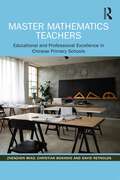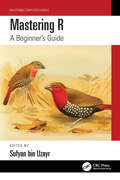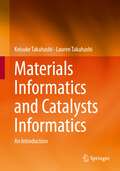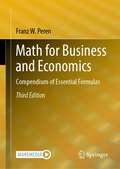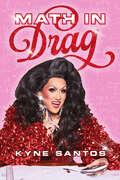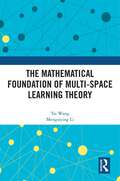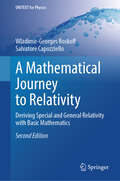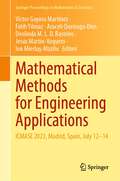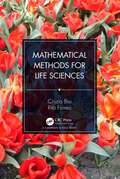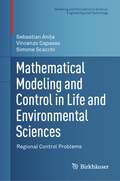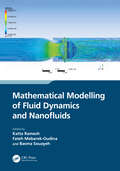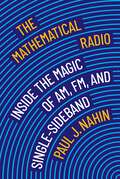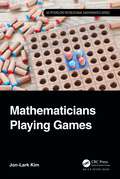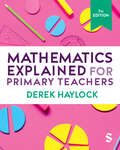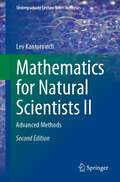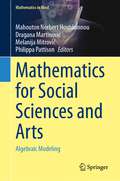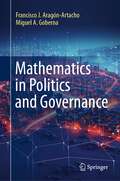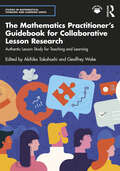- Table View
- List View
Master Mathematics Teachers: Educational and Professional Excellence in Chinese Primary Schools
by Zhenzhen Miao Christian Bokhove David ReynoldsThis practical guide invites teachers to take a journey towards masterly mathematics teaching using the experiences and lessons learnt across five Chinese provinces, Anhui, Beijing, Jiangsu, Jiangxi and Tianjin.On this journey, you will gain a thorough understanding of: (1) the quality and characteristics of master mathematics teachers’ teaching, (2) the quality of mathematics learning they have nurtured amongst their students in affective, metacognitive and cognitive dimensions and (3) the teaching-learning mechanisms that underpin excellent performance in the three dimensions. Alongside the quantitative and qualitative evidence on educational excellence, you will also delve deep into the trajectories and processes of professional development that generate professional excellence amongst master mathematics teachers and their peers within and across primary schools, up and down China.Building on data collected with 70 master mathematics teachers and 3,178 students and from teaching research events at the school, municipal, provincial and national levels, the Master Mathematics Teachers (MasterMT) project is, to date, the first that has looked at the legendary tribe of master mathematics teachers in China at such a large scale, and with such breadth and depth. The book offers invaluable insights for any teacher or teacher educator who wants to improve mathematics teaching and learning and generate educational and professional excellence in primary schools and beyond.More information on the Master Mathematics Teachers (MasterMT) project can be accessed at https://mastermt.org/.
Mastering R: A Beginner's Guide (Mastering Computer Science)
R is a statistical computing and graphics programming language that you can use to clean, analyze, and graph data. It is widely used by researchers from various disciplines to estimate and display results and by teachers of statistics and research methods. This book is a detailed guide for beginners to understand R with an explanation of core statistical and research ideas. One of the powerful characteristics of R is that it is open-source, which means that anyone can access the underlying code used to run the program and add their own code for free. It will always be able to perform the latest statistical analyses as soon as anyone thinks of them. R corrects mistakes quickly and transparently and has put together a community of programming and statistical experts that you can turn to for help. Mastering R: A Beginner’s Guide not only explains how to program but also how to use R for visualization and modeling. The fundamental principles of R explained here are helpful to beginner and intermediate users interested in learning this highly technological and diverse language.
Mastering R: A Beginner's Guide (Mastering Computer Science)
by Sufyan Bin UzayrR is a statistical computing and graphics programming language that you can use to clean, analyze, and graph data. It is widely used by researchers from various disciplines to estimate and display results and by teachers of statistics and research methods. This book is a detailed guide for beginners to understand R with an explanation of core statistical and research ideas. One of the powerful characteristics of R is that it is open-source, which means that anyone can access the underlying code used to run the program and add their own code for free. It will always be able to perform the latest statistical analyses as soon as anyone thinks of them. R corrects mistakes quickly and transparently and has put together a community of programming and statistical experts that you can turn to for help. Mastering R: A Beginner’s Guide not only explains how to program but also how to use R for visualization and modeling. The fundamental principles of R explained here are helpful to beginner and intermediate users interested in learning this highly technological and diverse language.
Materials Informatics and Catalysts Informatics: An Introduction
by Keisuke Takahashi Lauren TakahashiThis textbook is designed for students and researchers who are interested in materials and catalysts informatics with little to no prior experience in data science or programming languages. Starting with a comprehensive overview of the concept and historical context of materials and catalysts informatics, it serves as a guide for establishing a robust materials informatics environment. This essential resource is designed to teach vital skills and techniques required for conducting informatics-driven research, including the intersection of hardware, software, programming, machine learning within the field of data science and informatics. Readers will explore fundamental programming techniques, with a specific focus on Python, a versatile and widely-used language in the field. The textbook explores various machine learning techniques, equipping learners with the knowledge to harness the power of data science effectively. The textbook provides Python code examples, demonstrating materials informatics applications, and offers a deeper understanding through real-world case studies using materials and catalysts data. This practical exposure ensures readers are fully prepared to embark on their informatics-driven research endeavors upon completing the textbook. Instructors will also find immense value in this resource, as it consolidates the skills and information required for materials informatics into one comprehensive repository. This streamlines the course development process, significantly reducing the time spent on creating course material. Instructors can leverage this solid foundation to craft engaging and informative lecture content, making the teaching process more efficient and effective.
Math for Business and Economics: Compendium of Essential Formulas
by Franz W. PerenThis 3rd edition revised and extended compendium contains and explains essential mathematical formulas within an economic context. Newly added content introduces the mathematical practical application of optimization by using the Lagrange function, presenting the issue of linear optimization cases where the relative extremes (minima or maxima) of a linear (target) function can be determined under restrictive linear constraint and its relevance for business management practice. A broad range of aids and supportive examples will help readers to understand the formulas and their practical applications. This mathematical formulary is presented in a practice-oriented, clear, and understandable manner, as it is needed for meaningful and relevant application in global business, as well as in the academic setting and economic practice. The topics presented include but are not limited to mathematical signs and symbols, logic, arithmetic, algebra, linear algebra, combinatorics, and financial mathematics, including an international comparison between different national methods used in the calculation of interest, optimization of linear models, functions, differential calculus, integral calculus, elasticities, annuity calculation, economic functions, and the Peren Theorem.Given its scope, the book offers an indispensable reference guide and is a must-read for undergraduate and graduate students, as well as managers, scholars, and lecturers in business, politics, and economics.
The Mathematical Foundation of Multi-Space Learning Theory
by Tai Wang Mengsiying LiThis book explores the measurement of learning effectiveness and the optimization of knowledge retention by modeling the learning process and building the mathematical foundation of multi-space learning theory.Multi-space learning is defined in this book as a micro-process of human learning that can take place in more than one space, with the goal of effective learning and knowledge retention. This book models the learning process as a temporal sequence of concept learning, drawing on established principles and empirical evidence. It also introduces the matroid to strengthen the mathematical foundation of multi-space learning theory and applies the theory to vocabulary and mathematics learning, respectively. The results show that, for vocabulary learning, the method can be used to estimate the effectiveness of a single learning strategy, to detect the mutual interference that might exist between learning strategies, and to predict the optimal combination of strategies. In mathematical learning, it was found that timing is crucial in both first learning and second learning in scheduling optimization to maximize the intersection effective interval.The title will be of interest to researchers and students in a wide range of areas, including educational technology, learning sciences, mathematical applications, and mathematical psychology.
The Mathematical Foundation of Multi-Space Learning Theory
by Tai Wang Mengsiying LiThis book explores the measurement of learning effectiveness and the optimization of knowledge retention by modeling the learning process and building the mathematical foundation of multi-space learning theory.Multi-space learning is defined in this book as a micro-process of human learning that can take place in more than one space, with the goal of effective learning and knowledge retention. This book models the learning process as a temporal sequence of concept learning, drawing on established principles and empirical evidence. It also introduces the matroid to strengthen the mathematical foundation of multi-space learning theory and applies the theory to vocabulary and mathematics learning, respectively. The results show that, for vocabulary learning, the method can be used to estimate the effectiveness of a single learning strategy, to detect the mutual interference that might exist between learning strategies, and to predict the optimal combination of strategies. In mathematical learning, it was found that timing is crucial in both first learning and second learning in scheduling optimization to maximize the intersection effective interval.The title will be of interest to researchers and students in a wide range of areas, including educational technology, learning sciences, mathematical applications, and mathematical psychology.
A Mathematical Journey to Relativity: Deriving Special and General Relativity with Basic Mathematics (UNITEXT for Physics)
by Wladimir-Georges Boskoff Salvatore CapozzielloThe 2nd edition of this textbook features more than 100 pages of new material, including four new chapters, as well as an improved discussion of differential geometry concepts and their applications. The textbook aims to provide a comprehensive geometric description of Special and General Relativity, starting from basic Euclidean geometry to more advanced non-Euclidean geometry and differential geometry. Readers will learn about the Schwarzschild metric, the relativistic trajectory of planets, the deflection of light, the black holes, and the cosmological solutions like de Sitter, Friedman-Lemaître-Robertson-Walker, and Gödel ones, as well as the implications of each of them for the observed physical world. In addition, the book provides step-by-step solutions to problems and exercises, making it an ideal introduction for undergraduate students and readers looking to gain a better understanding of Special and General Relativity. In this new edition, a wide discussion on metric-affine theories of gravity and equivalent formulations of General Relativity is reported. The aim is presenting also topics which could be useful for PhD students and researchers studying General Relativity from an advanced point of view.
Mathematical Methods for Engineering Applications: ICMASE 2023, Madrid, Spain, July 12–14 (Springer Proceedings in Mathematics & Statistics #439)
by Víctor Gayoso Martínez Fatih Yilmaz Araceli Queiruga-Dios Deolinda M. L. D. Rasteiro Jesús Martín-Vaquero Ion Mierluş-MaziluThese proceedings gather selected, peer-reviewed papers presented at the IV International Conference on Mathematics and its Applications in Science and Engineering – ICMASE 2023, held on July 12–14, 2023 by the University Center of Technology and Digital Arts (U-tad) in Madrid, Spain.Papers in this volume cover new developments in applications of mathematics in science and engineering, with an emphasis on mathematical and computational modeling of real-world problems. Topics range from the use of differential equations to model mechanical structures to the employ of number theory in the development of information security and cryptography. Educational issues specific to the acquisition of mathematical competencies by engineering and science students at all university levels are also touched on.Researchers, practitioners, and university students can significantly benefit from this volume, especially those seeking advanced methods for applying mathematics to various contexts and fields.
Mathematical Methods for Life Sciences
by Cinzia Bisi Rita FioresiMathematical Methods for Life Sciences introduces calculus, and other key mathematical methods, to students from applied sciences (biology, biotechnology, chemistry, pharmacology, material science, etc). Special attention is paid to real-world applications, and for every concept, many concrete examples are provided. The book does not aim to enable students to prove theorems and construct elaborate proofs, but rather to leave students with a clear understanding of the practical mathematics behind the power of optimization, dynamical systems, and all the predictive tools these theories give rise to.Features No prerequisites beyond high school algebra and geometry Could serve as the primary text for a first-year course in mathematical methods for biology, biotechnology, or other life sciences Easy to read: the students may skip all the proofs and go directly to key examples and applications Cinzia Bisi is a professor of Geometry at the Department of Mathematics and Computer Sciences at the University of Ferrara, Italy. She has wide experience in teaching mathematics and statistics to students in the Department of Life Sciences. She has an interest in the areas of pure and applied mathematics. Rita Fioresi is a professor of Geometry at the FaBiT Department at the University of Bologna, Italy. She has written textbooks in linear algebra, and her research interests are primarily in the areas of pure and applied mathematics. .
Mathematical Methods for Life Sciences
by Cinzia Bisi Rita FioresiMathematical Methods for Life Sciences introduces calculus, and other key mathematical methods, to students from applied sciences (biology, biotechnology, chemistry, pharmacology, material science, etc). Special attention is paid to real-world applications, and for every concept, many concrete examples are provided. The book does not aim to enable students to prove theorems and construct elaborate proofs, but rather to leave students with a clear understanding of the practical mathematics behind the power of optimization, dynamical systems, and all the predictive tools these theories give rise to.Features No prerequisites beyond high school algebra and geometry Could serve as the primary text for a first-year course in mathematical methods for biology, biotechnology, or other life sciences Easy to read: the students may skip all the proofs and go directly to key examples and applications Cinzia Bisi is a professor of Geometry at the Department of Mathematics and Computer Sciences at the University of Ferrara, Italy. She has wide experience in teaching mathematics and statistics to students in the Department of Life Sciences. She has an interest in the areas of pure and applied mathematics. Rita Fioresi is a professor of Geometry at the FaBiT Department at the University of Bologna, Italy. She has written textbooks in linear algebra, and her research interests are primarily in the areas of pure and applied mathematics. .
Mathematical Modeling and Control in Life and Environmental Sciences: Regional Control Problems (Modeling and Simulation in Science, Engineering and Technology)
by Sebastian Aniţa Vincenzo Capasso Simone ScacchiThis monograph explores the use of mathematical modeling and control theory in a variety of contemporary challenges in mathematical biology and environmental sciences. Emphasizing an approach of learning by doing, the authors focus on a set of significant case studies emerging from real-world problems and illustrate how mathematical techniques and computational experiments can be employed in the search for sustainable solutions.The following topics are extensively discussed:Eradicability and control of a paradigmatic epidemic model, with a view to the existence of endemic states, their stability, and the existence of travelling wavesA spatially structured epidemic model concerning malaria as an example of vector-borne epidemicsOptimal harvesting problems for space-structured and age-structured population dynamicsControlling epidemics in agriculture due to pest insectsThe role of predators as a possible biocontrol agent of epidemics in agricultureControl by taxation of the environmental pollution produced by human activitiesThe originality of this text is in its leitmotif – regional control – along the principle of “Think Globally, Act Locally.” Indeed, for example, in many real spatially structured ecosystems, it is practically impossible to control the relevant system by global interventions in the whole habitat.Proofs are given whenever they may serve as a guide to the introduction of new concepts. Each chapter includes a comprehensive description of the numerical methods used for the computational experiments, and MATLAB© codes for many of the numerical simulations are available for download. Several challenging open problems are also provided to stimulate future research.This text is aimed at mathematicians, engineers, and other scientists working in areas such as biology, medicine, and economics. Graduate and advanced undergraduate students of a quantitative subject related to the analysis and applications of dynamical systems and their control will also find it to be a valuable resource.
Mathematical Modelling of Fluid Dynamics and Nanofluids
by Katta Ramesh Fateh Mebarek-Oudina Basma SouayehMathematical Modelling of Fluid Dynamics and Nanofluids serves as a comprehensive resource for various aspects of fluid dynamics simulations, nanofluid preparation, and numerical techniques.The book examines the practical implications and real-world applications of various concepts, including nanofluids, magnetohydrodynamics, heat and mass transfer, and radiation. By encompassing these diverse domains, it offers readers a broad perspective on the interconnectedness of these fields.The primary audience for this book includes researchers and graduate students who possess a keen interest in interdisciplinary studies within the realms of fluid dynamics, nanofluids, and biofluids. Its content caters to those who wish to deepen their knowledge and tackle complex problems at the intersection of these disciplines.
Mathematical Modelling of Fluid Dynamics and Nanofluids
by Katta Ramesh Fateh Mebarek-Oudina Basma SouayehMathematical Modelling of Fluid Dynamics and Nanofluids serves as a comprehensive resource for various aspects of fluid dynamics simulations, nanofluid preparation, and numerical techniques.The book examines the practical implications and real-world applications of various concepts, including nanofluids, magnetohydrodynamics, heat and mass transfer, and radiation. By encompassing these diverse domains, it offers readers a broad perspective on the interconnectedness of these fields.The primary audience for this book includes researchers and graduate students who possess a keen interest in interdisciplinary studies within the realms of fluid dynamics, nanofluids, and biofluids. Its content caters to those who wish to deepen their knowledge and tackle complex problems at the intersection of these disciplines.
The Mathematical Radio: Inside the Magic of AM, FM, and Single-Sideband
by Paul J. NahinHow a modern radio works, told through mathematics, history, and selected puzzlesThe modern radio is a wonder, and behind that magic is mathematics. In The Mathematical Radio, Paul Nahin explains how radios work, deploying mathematics and historical discussion, accompanied by a steady stream of intriguing puzzles for math buffs to ponder. Beginning with oscillators and circuits, then moving on to AM, FM, and single-sideband radio, Nahin focuses on the elegant mathematics underlying radio technology rather than the engineering. He explores and explains more than a century of key developments, placing them in historical and technological context.Nahin, a prolific author of books on math for the general reader, describes in fascinating detail the mathematical underpinnings of a technology we use daily. He explains and solves, for example, Maxwell&’s equations for the electromagnetic field. Readers need only a familarity with advanced high school–level math to follow Nahin&’s mathematical discussions. Writing with the nonengineer in mind, Nahin examines topics including impulses in time and frequency, spectrum shifting at the transmitter, the superheterodyne, the physics of single-sideband radio, and FM sidebands. Chapters end with &“challenge problems&” and an appendix offers solutions, partial answers, and hints. Readers will come away with a new appreciation for the beauty of even the most useful mathematics.
Mathematicians Playing Games (AK Peters/CRC Recreational Mathematics Series)
by Jon-Lark KimMathematicians Playing Games explores a wide variety of popular mathematical games, including their historical beginnings and the mathematical theories that underpin them. Its academic level is suitable for high school students and higher, but people of any age or level will find something to entertain them, and something new to learn. It would be a fantastic resource for high school mathematics classrooms or undergraduate mathematics for liberal arts course and belongs on the shelf of anyone with an interest in recreational mathematics. Features Suitable for anyone with an interest in games and mathematics, and could be especially useful to middle and high school students and their teachers Includes various exercises for fun for readers.
Mathematicians Playing Games (AK Peters/CRC Recreational Mathematics Series)
by Jon-Lark KimMathematicians Playing Games explores a wide variety of popular mathematical games, including their historical beginnings and the mathematical theories that underpin them. Its academic level is suitable for high school students and higher, but people of any age or level will find something to entertain them, and something new to learn. It would be a fantastic resource for high school mathematics classrooms or undergraduate mathematics for liberal arts course and belongs on the shelf of anyone with an interest in recreational mathematics. Features Suitable for anyone with an interest in games and mathematics, and could be especially useful to middle and high school students and their teachers Includes various exercises for fun for readers.
Mathematics Explained for Primary Teachers
by Derek HaylockBuild your confidence in the primary classroom Deepen your own mathematical subject knowledge Discover why generations of primary teachers have relied on Derek Haylock’s explanations of key mathematical concepts to support their understanding and strengthen their teaching This seventh edition has been fully updated to offer a broader exploration of mastery teaching, deeper connections to contemporary research and new coverage of how children learn to count. It is supported by a fantastic range of online resources including lesson plans, videos and test questions to extend your own learning.
Mathematics Explained for Primary Teachers
by Derek HaylockBuild your confidence in the primary classroom Deepen your own mathematical subject knowledge Discover why generations of primary teachers have relied on Derek Haylock’s explanations of key mathematical concepts to support their understanding and strengthen their teaching This seventh edition has been fully updated to offer a broader exploration of mastery teaching, deeper connections to contemporary research and new coverage of how children learn to count. It is supported by a fantastic range of online resources including lesson plans, videos and test questions to extend your own learning.
Mathematics Explained for Primary Teachers
by Derek HaylockBuild your confidence in the primary classroom Deepen your own mathematical subject knowledge Discover why generations of primary teachers have relied on Derek Haylock’s explanations of key mathematical concepts to support their understanding and strengthen their teaching This seventh edition has been fully updated to offer a broader exploration of mastery teaching, deeper connections to contemporary research and new coverage of how children learn to count. It is supported by a fantastic range of online resources including lesson plans, videos and test questions to extend your own learning.
Mathematics for Natural Scientists II: Advanced Methods (Undergraduate Lecture Notes in Physics)
by Lev KantorovichThis textbook, the second in a series (the first covered fundamentals and basics), seeks to make its material accessible to physics students. Physics/engineering can be greatly enhanced by knowledge of advanced mathematical techniques, but the math-specific jargon and laborious proofs can be off-putting to students not well versed in abstract math. This book uses examples and proofs designed to be clear and convincing from the context of physics, as well as providing a large number of both solved and unsolved problems in each chapter. This is the second edition, and it has been significantly revised and enlarged, with Chapters 1 (on linear algebra) and 2 (on the calculus of complex numbers and functions) having been particularly expanded. The enhanced topics throughout the book include: vector spaces, general (non-Hermitian, including normal and defective) matrices and their right/left eigenvectors/values, Jordan form, pseudoinverse, linearsystems of differential equations, Gaussian elimination, fundamental theorem of algebra, convergence of a Fourie series and Gibbs-Wilbraham phenomenon, careful derivation of the Fourier integral and of the inverse Laplace transform. New material has been added on many physics topics meant to illustrate the maths, such as 3D rotation, properties of the free electron gas, van Hove singularities, and methods for both solving PDEs with a Fourier transform and calculating the width of a domain wall in a ferromagnet, to mention just a few. This textbook should prove invaluable to all of those with an interest in physics/engineering who have previously experienced difficulty processing the math involved.
Mathematics for Social Sciences and Arts: Algebraic Modeling (Mathematics in Mind)
by Mahouton Norbert Hounkonnou Dragana Martinovic Melanija Mitrović Philippa PattisonThis book addresses interconnections between contemporary advances in mathematics, especially algebra, with applications in the social sciences and the arts. It promotes the idea that knowledge cannot remain in disciplinary silos, rather, it belongs to all people, and is dedicated to associative relationships in a variety of mathematics applications, from sociology to linguistics, including anthropology, semiotics, education, and cognitive science. Contributions illuminate some of the ways in which algebra is developed, learned, understood, communicated, and applied in the social sciences and the humanities.The content in this book has its origins in a conference, Mathematics for Social Sciences and Arts–Algebraic Modelling, virtually hosted by the Faculty of Mechanical Engineering, University of Niš, Serbia, from the 24th to the 26th of May, 2021. This conference brought together scholars from various disciplines and geographic regions and focused on the juxtaposition of algebra and social science applications. The conference organizers, higher education institutes from four different continents, invited leading scientists in social sciences and algebra, to contribute to this volume.The first part of this book addresses algebraic and mathematical thinking, specifically learning and practicing mathematics from a cognitive science perspective, as well as illustrative applications to distinctly human concerns, like education and semiotics. The second part focuses on algebraic semigroups and some of their generalizations. This book and the conference that engendered it provide an example of a fruitful collaboration, in which the skills and deep knowledge of algebraic structures, modeling, social sciences and arts brought in by the authors from different countries and continents merge in harmonious ways. These expositions are a rich resource and are of interest both to mathematicians and non-mathematicians.
Mathematics in Politics and Governance
by Francisco J. Aragón-Artacho Miguel A. GobernaThis book presents the mathematical tools that politicians use to make rational decisions about health, education, culture, economy, finance, transportation, and national defense for their citizens. The selection of topics addressed is based on the experiences of four veteran politicians who have doctorates or master’s degrees in mathematics. The exposition also considers the mathematical tools used by politicians to capture votes or optimize their impact on the design of electoral districts, i.e., gerrymandering, without forgetting the mathematics applied to parliamentary activity and political science.Aimed at a general educated readership, a basic knowledge of mathematics is the only requisite to understanding most of the book. Certain sections, denoted in the book with a star, contain more advanced material and require some knowledge of undergraduate math. A later chapter is dedicated to applications and techniques of machine learning and the final chapter discusses a variety of cases where political decisions have affected mathematical development. Readers gravitating towards this book are those who are curious about the history of mathematics, including optimizers and mathematicians who would like to learn more about the historical roots of their discipline. There will also be strong appeal to mathematically-oriented economists, political scientists, and people generally interested in mathematics.Mathematics is – or it should be! – an important part of our culture. The impact of mathematics is sometimes silent, but a powerful one. The authors of this book did an incredible work in digging out areas of mathematical reasoning that pervades social and political life. Reading this book, we will all enrich our vision of mathematics’ value for society.(Nuno Crato, Professor of Applied Mathematics, University of Lisbon, former minister of Education and Science of Portugal 2011–2015)This monograph shows in an impressive way that mathematics can be very helpful in making and evaluating political decisions and that it is indispensable in the progressive penetration of all areas of society with scientific methods. This also includes politics. Not everything in politics can be justified or related to mathematics, but politics should not be made in contradiction to mathematical truths. For me, this is a central message of this publication.(Johanna Wanka, Professor of Applied Mathematics, Merseburg University of Applied Sciences, former Minister of Education and Research, Germany 2013–2018)
The Mathematics Practitioner’s Guidebook for Collaborative Lesson Research: Authentic Lesson Study for Teaching and Learning (Studies in Mathematical Thinking and Learning Series)
by Akihiko Takahashi Geoffrey WakeThis resource provides mathematics educators with tools for conducting Collaborative Lesson Research (CLR), a form of Lesson Study developed out of the original Japanese Lesson Study and intended to improve student and teacher learning. Renowned mathematics education researchers Akihiko Takahashi and Geoffrey Wake bring together educators across the US and UK with first-hand experience using CLR in their schools. Readers will learn the essentials for an impactful Lesson Study directly from the scholars who coined the term, and benefit from the dual perspectives of math education researchers and teachers who have used CLR when reflecting on their own classroom pedagogy. These contributors define CLR and provide examples of successful CLR using real-life case studies, as well as introducing pathways for getting started and practical suggestions for implementation into different school environments. Across these examples, readers will: understand the essence of Lesson Study, considered as CLR, and its important features be advised what participants in CLR should expect to do (observing research lessons, designing lessons, teaching research lessons, facilitating post-lesson discussion, etc.) and provide guidance and support with this enactment be advised on how to develop, embed, and sustain CLR communities preview potential outcomes over time from undertaking CLR Research lesson proposals and plans to support readers in understanding CLR are also included. Ideal for practicing teachers, teacher leaders, teacher educators, and professional developers involved in mathematics teaching, this book offers first-of-its-kind entry points for CLR. Its combination of theory and practice will empower educators to implement this increasingly popular vehicle for understanding students’ learning of mathematics.
